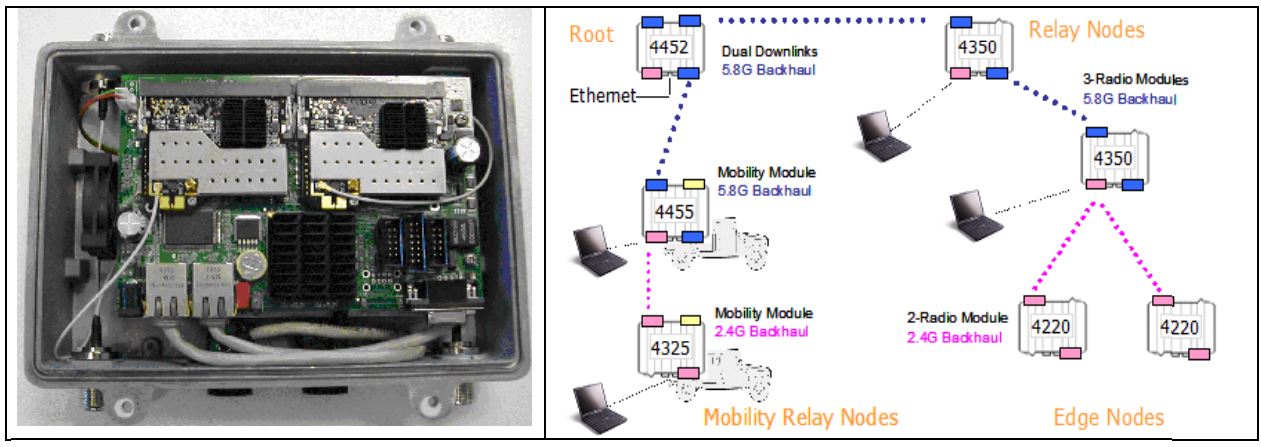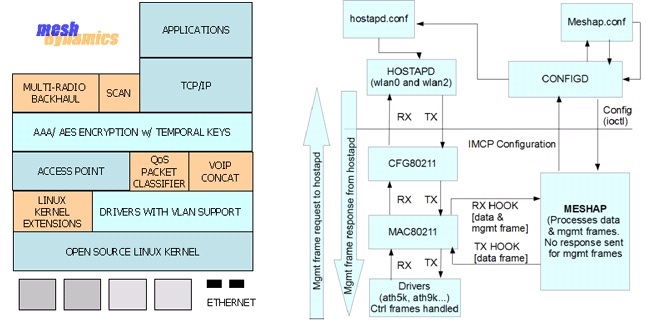Fig.1 Distributed Radio Intelligence at is
radio and protocol agnostic -- by design (dual use)
 The power of Distributed,
Dynamic, Radio Intelligence.
The power of Distributed,
Dynamic, Radio Intelligence.
Sustainable Wireless
Mesh Networks must proactively avoid
co-channel interference
from multiple radios operating in the same frequency band.
Meshdynamics automates channel-selection and
topology by distributing dynamic radio
intelligence in each node, in effect creating multiple "RF
robots". Patented algorithms enable all nodes to
periodically SCAN its environment to
determine its relationship with neighboring nodes, alternate
paths, and
extraneous and potentially
interfering radio sources.
In this distributed dynamic radio intelligence approach, the
network forms a
tree-like structure emanating from one or more "root"
nodes that have the wired or fiber connection to the Internet
or intranet. As the branches of the "tree" radiate outward,
eventually they become geographically distant enough from one
another for nodes to begin re-using channels. This increases the capacity of the network,
making better use of the scarcest resource: the number of non
interfering RF channels available.
The independent but coordinated "RF robots" in nodes are
useful in detecting and avoiding
external
interference sources.
Nodes close to these RF sources move - in
coordinated fashion - to a less used channel. Impact to end users is minimized.
 MeshControlTM : Radio
Card and Wireless Protocol Agnostic - by Design.
MeshControlTM : Radio
Card and Wireless Protocol Agnostic - by Design.
Meshdynamics' Third
Generation implementation is not limited to any particular number or type of
physical radios, or indeed to the concept of separate physical radios at
all. Instead, the Meshdynamics MeshControlTM
mesh networking algorithm treats physical and/or logical
radios as a pool of available connections to be dynamically
managed for optimum performance.
The MeshControlTM
software (items orange, above) is uniquely radio-manufacturer
independent, allowing the rapid addition of new radio
frequencies, radio suppliers and new technologies. The
MeshControlTM software is
therefore future-proof: it can been upgraded to new RF standards, as they
become proven and commercially feasible.
Decoupling the logical channel-selection and
topology-definition processes from the specific physical
radio in this fashion delivers distributed dynamic radio
intelligence benefits for current as well as emerging radio
standards.
An additional benefit of decoupling the distributed dynamic radio intelligence
(e.g. controlling channel selection and topology
configuration) from the radio hardware, is the potential to incorporate
(lower cost) commercial-off-the-shelf (COTS) radios.
This substantially decreases time-to-market and greatly
increases manufacturing scale, reducing both development- and
unit cost over the use of custom hardware development.
 Modular MeshTM Products Extend Logical
Network Edge seamlessly
Modular MeshTM Products Extend Logical
Network Edge seamlessly

|
Fig 2: Modular Mesh supports up to 4 radios
Fig 3: Interoperability between 5 GHz and 2.4 GHz sub trees |
The MeshControlTM
software takes
Radio
Frequency Agility one step further in our
Modular MeshTM
products. Figure 2 shows how this level of flexibility is leveraged
in the MD4000 4 radio products. There are 4 mini-PCI slots on the board, two on the bottom and two on top. Each of the four slots can house a different frequency radio. This opens up some interesting possibilities including 2.4 GHz backhaul systems being part of a mesh with 5.8 GHz backhauls.
The service and backhaul radios are distinct, and operating in different
domains/channels, it is possible to use a service radio to bridge over from a 5.8 GHz backhaul to 2.4 GHz backhaul,
see Fig
3. The 4325 Mobility Relay node on the bottom left has joined the mesh – even though the upper links are 5.8 GHz (blue) – through the service radio (pink).
The physical network edge bridges between two distinct frequency bands
and potentially disparate radio communication protocols. The logical
network abstraction, using "logical" ports simply extends the network
tree. Wired Switch Equivalence
Meshdynamics' powerful networking algorithms are designed to work over a variety
of civilian and military radio bands. Custom radio device driver development
capabilities are available, operating in even broader ranges of bands and
protocols.
A device and communication protocol abstracted framework
emerges, with tight integration with local and remote
"machine controller" applications that orchestrate the sensor-actuator
interactions and the feedback command and control loops.
